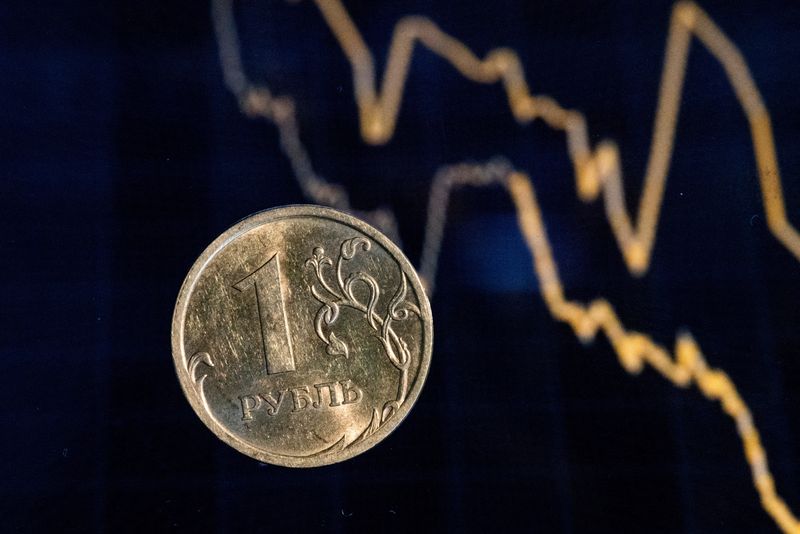Forex
Russian rouble tumbles to over 18-month low vs dollar


© Reuters. FILE PHOTO: A view shows a Russian one rouble coin in front of a screen in this illustration picture taken August 22, 2023. REUTERS/Maxim Shemetov/Illustration/File Photo
By Alexander Marrow
(Reuters) – The rouble slumped to a more than 18-month low against the dollar on Monday past the 102 mark, still hampered by reduced foreign currency supply and struggling to latch on to higher oil prices as the violence in Israel hurt risk appetite.
Israel’s troops were battling on Monday to clear out Hamas gunmen more than two days after they burst across the fence from Gaza on a deadly rampage, and the army said it would soon go on the offensive after the biggest mobilisation in Israeli history.
By 1125 GMT, the rouble was 1.8% weaker against the dollar at 102.18, its weakest point since March 23, 2022. The Russian currency tumbled to a record low 121.5275 in the weeks after Moscow’s February 2022 invasion of Ukraine.
The rouble had lost 1.9% to trade at 107.76 versus the euro and shed 2.1% against the yuan to 14.01.
The rouble’s last tumble into triple digits in August led the Bank of Russia to make an emergency 350 basis-point rate hike to 12% and authorities to discuss reintroducing controls to buttress the currency, but interventions – verbal or otherwise – have been more limited this time around.
Rates were lifted to 13% in September and analysts polled by Reuters expect the central bank to hike again on Oct. 27, with persistent rouble weakness among the factors limiting Russia’s long-term growth prospects.
, a global benchmark for Russia’s main export, was up 3.4% at $87.46 a barrel, lifted by the military conflict in the Middle East.
Russia’s finance ministry’s expects tax revenues from energy companies to rise in October.
“If these forecasts come true, then oil companies will have to sharply increase the volume of sales of FX revenues for settlements with the budget,” said Alor Broker’s Alexei Antonov.
He said that exporters were unlikely to limit FX sales until the end of the month, when taxes are due, meaning that the rouble could start recovering this week.
Russian stock indexes were mixed.
The dollar-denominated RTS index was down 0.5% to 981.9 points. The rouble-based MOEX Russian index was 1.3% higher at 3,184.6 points, a near one-month high.

 Forex3 years ago
Forex3 years agoForex Today: the dollar is gaining strength amid gloomy sentiment at the start of the Fed’s week

 Forex3 years ago
Forex3 years agoUnbiased review of Pocket Option broker

 Forex3 years ago
Forex3 years agoDollar to pound sterling exchange rate today: Pound plummeted to its lowest since 1985

 Forex3 years ago
Forex3 years agoHow is the Australian dollar doing today?

 Cryptocurrency3 years ago
Cryptocurrency3 years agoWhat happened in the crypto market – current events today

 World3 years ago
World3 years agoWhy are modern video games an art form?

 Commodities3 years ago
Commodities3 years agoCopper continues to fall in price on expectations of lower demand in China

 Economy3 years ago
Economy3 years agoCrude oil tankers double in price due to EU anti-Russian sanctions





















